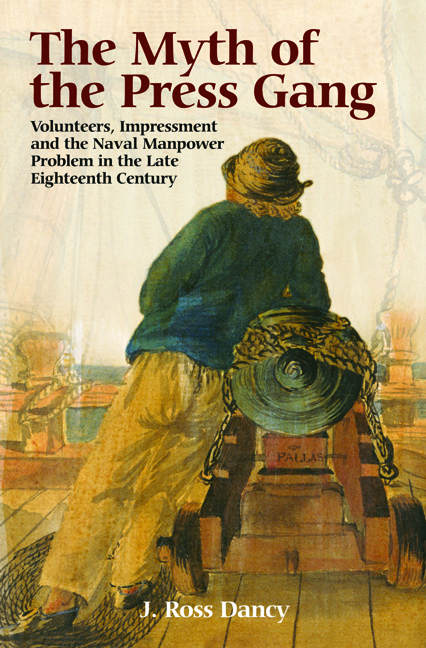 The Myth of the Press Gang
The Myth of the Press Gang 1 - British Naval Administration
Published online by Cambridge University Press: 05 May 2015
Summary
Beyond financing the naval war, the manning problem was the greatest hurdle that British naval administrators faced at the opening of the French Revolutionary Wars, and continued to be one of the most controversial and difficult obstacles over the twenty-two years of conflict that followed. By the end of the French Revolutionary Wars, the Royal Navy had grown into a force of over 130,000 men. Less than a century and a half earlier, Charles II's wartime Navy had consisted of only about 20,000 men. The English Navy of the 1660s was designed to fight in the North Sea, close to its own support facilities, while the Navy of 1801 had spread its influence well outside of the North Atlantic, into the Indian and Pacific Oceans. These changes required an efficient and effective infrastructure and administration more than ever before. All aspects of naval support, including construction, repair, victualling, manning, and more, had to grow in size and efficiency to cope with expanding naval commitments. By the end of the eighteenth century, this growth had produced a fleet capable of harassing, and in some cases nearly halting, communication between continental Europe and its colonies, while British merchants carried trade across the globe. The strength of the Royal Navy allowed George III and his government ministers to sit behind Britain's ‘wooden walls’ with relative confidence while attrition took a heavy toll on their enemies. The English Navy of the Restoration never afforded such luxuries.
The objective of this chapter is to trace British naval administration as it applied to manning, from the Restoration of 1660, through to the opening of the French Revolutionary Wars in 1793. It is not an attempt to re-write administrative history, but to provide a background for better understanding the history behind the manpower problems that faced naval administrators when war broke out in 1793.
The Restoration and Naval Advancement
When Charles II came to power in 1660, the English Navy was the strongest element of his newly inherited government.
- Type
- Chapter
- Information
- The Myth of the Press GangVolunteers, Impressment and the Naval Manpower Problem in the Late Eighteenth Century, pp. 11 - 27Publisher: Boydell & BrewerPrint publication year: 2015
